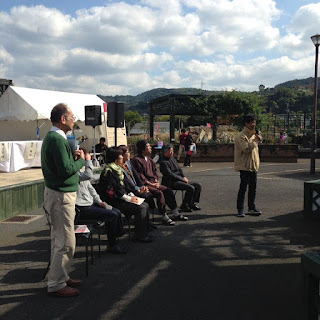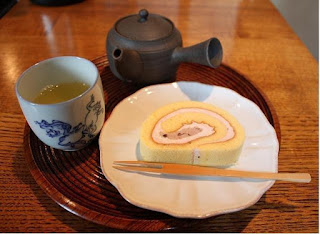It is the year of
tea in Kyoto. Lots of events are held in Kyoto throughout the year (from April
2017 through March 2018) under the name of “Discover Premium Green”.
One of the events,
but the first one as an international version, “International Expo” was held on
Nov.10 and 11. Some tea-related groups from overseas participated it.
One of the exhibitors is
“Tea Gardens of Scotland (TGS)”, which is a group of nine of female tea farmers
who grow tea in Scotland!
In Japan, it's generally said
that Akita prefecture, which is located at lat.40 NL is the northernmost place for growing tea. Scotland is further north! So I was surprised to hear
that tea has been cultivated in Scotland, and I was so excited to know that
people who grow tea in Scotland were coming to Japan.
Ms Beverly Wainwright, the adviser of TGS, and Ms Catherine Drummond-Herdman, one tea farmer of the group attended this Kyoto Expo all the way from Scotland, and spoke about
what they have been doing and their visions.
 |
| Micro-scale artisan tea production for Sri Lanka to Scotland by Mrs Wainwright |
 |
| Megginch Castle Our family tea story, so far by Mrs Drummond-Herdman |
They also promoted
these at the venue:
Tea
“Kinnettles Gold”: the one of the group produced as the first tea
grown and produced in Scotland, which means 100% pure Scottish tea. Many who came to
the event were tea people including farmers, workers for tea factory and tea
shops, who all know how tough the tea producing is. They were surprised,
impressed, and amazed by what TGS members have been doing. And they really appreciate the tea with a delicate flavour, a hint of honey-sweet taste and a beautiful
golden colour. I remember a lady who tasted said “ I
can really tell this tea has been raised and produced with tender loving care."
Japanese style
teacup known as yunomi by Crail Pottery, which is specially designed for this expo. You would feel warm and relaxed when you hold the cup gently and carefully with both hands as if you wrap it with two hands. Happy blending of Scotland and Japan.
Scottish sweets: savory seaweed shortbread from Stag bakers, and mini round shortbread from Your
Piece baking company.
Actually, very
luckily and happily, I had a chance to talk and spend the time with them
privately.
The more I hear their ideas and passions, the more I feel impressed.The more I learn
about their visions, the more I find common ground with Wakocha (Japanese black
tea) ---- trying to produce
unique tea, which can be made only in that region, working together with local
specialty including food and pottery etc, deepening the band of community
through local tea, boosting the local economy through local tea industry-----
Beverly has
already succeeded in breathing new life into many tea estates and its community, and supported
small-scale tea places. One of the places she revived is the Amba estate in Sri
Lanka. It must have been a tough job. She said she made a lots of failures
before she made a success, but she had never given up. I’m enormously impressed
by her perseverance and strength when listening her story of tea life. Also the
words she repeated stayed with me: that is; “ prepare for failure”, “failure is
leaning”..
Nine members of
“Tea Gardens of Scotland” including Catherine have been challenging the big
project, which had never been done before in Scotland. Catherine says “Nobody
did tea production in Scotland before. That’s why it’s good!” Also, when she
talks about what she wants to do, she doesn’t use the word of “dream”. She says
“vision” instead. I can see her strong determination and I can tell she can
definitely see what to do.
I assume there are
still lots of difficulties ahead of them. It won’t be easy to be a trailblazer.
But I believe Catherine and other eight members will see them through, and their
visions and passions will be realized under the advice of the person of
indomitable will, Beverly. Yes, they will make it happen!









































